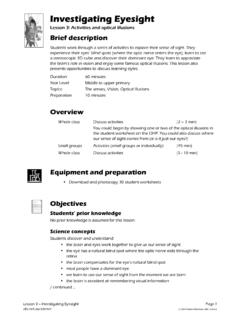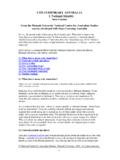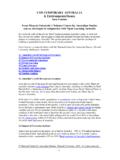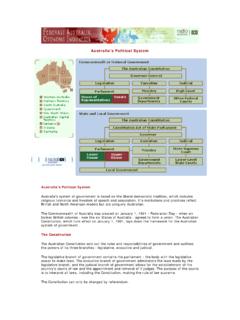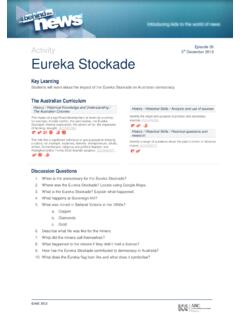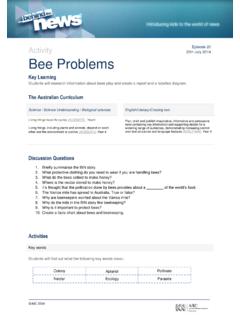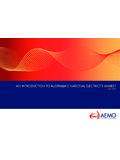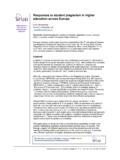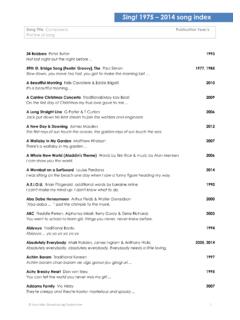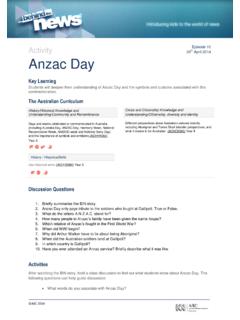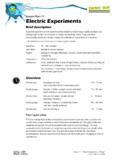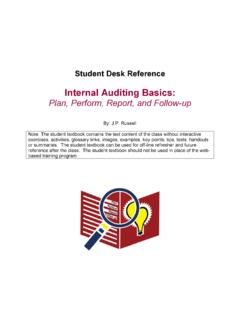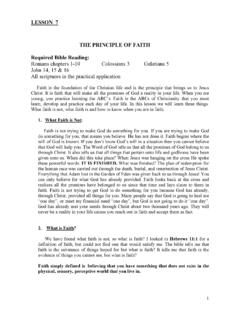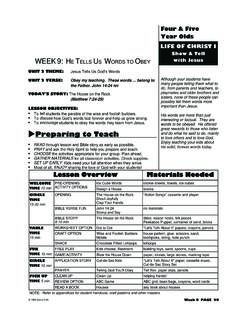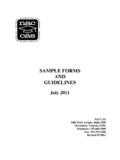Transcription of Lesson Plan 10 - ABC - Australian Broadcasting …
1 Lesson plan 15. Cool Colour Experiment Brief description Students predict how food dyes from four chocolate buttons will mix in water. The surprising result demonstrates the role of prior knowledge in making predictions and fosters positive attitudes to unexpected outcomes. This Lesson is also perfect for learning to work cooperatively in small groups or as a rainy days Lesson ! Duration: 30 45 minutes total Year level: Lower to upper primary Topics: Energy and Change, Natural and Processed Materials, Density, Solutions and mixing Preparation: 5 to 10 minutes Overview To conserve water and resources, conduct this activity in small groups.
2 Each student can contribute to the activity by swapping tasks between each step. Introduction Whole Class (5 10 min). Discuss the activities and allocate group jobs Complete Worksheet Activities Small Groups (20 25 min). Students conduct the experiments in small groups. Water can be conserved and recycled using a bucket waste water can then be used to water plants in the school garden Whole Class Discussion and reflection (5 10 min). Discuss the activities and outcomes Planning for safety: Younger students may need assistance with food dye as it can leave stains.
3 Students should empty used water into a large bucket which can then be used on plants. Lesson 15 Cool Colour Experiments Page 1. 2007 | ABC Science Online Materials and equipment y 1 large bag of coated chocolate buttons y 6 10 round dishes* approx. 7 to 8cm diameter (1 per group). y Food dye (with eye-dropper). y Water y Bucket (for collecting / recycling water). y Student Worksheets (1 per student). * white screw top lids work well or place clear plastic containers placed on white paper Objectives Students' prior knowledge No prior knowledge is required or assumed for this Lesson plan .
4 Science skills Students will: Read all the instructions carefully before beginning the activities Observe that a single drop of food dye does not mix rapidly in still water Observe that the food dye from the shell of a chocolate button mixes more rapidly in water Predict how the food dye from four chocolate buttons will mix in water Record their observations using diagrams and written descriptions Infer that the presence sugar is causing the food dye from the chocolate buttons to spread Science concepts Sugar dissolves in water Food dye dissolves in water Sugar solutions do not mix rapidly
5 If their concentrations are equal Positive attitudes Students will Appreciate the importance of prior knowledge for making accurate predictions Welcome surprising results as an opportunity for further investigation and learning Appreciate that scientific investigations often yield surprising results Work cooperatively in small groups Conserve water and handle equipment carefully Lesson 15 Cool Colour Experiments Page 2. 2007 | ABC Science Online Procedure Introduction whole class (5 10 min). Discuss the activity and procedures Allocate group jobs and rotations Discuss safety (eg minimising walking through the classroom with water).
6 Complete worksheet activities small groups (20 25 min). Students perform the activities in small groups Students complete their worksheets individually they should record their predictions prior to completing the activity for later comparison Each group should empty their used water and chocolate buttons into a class bucket for recycling Teacher assistance with food dye is required for younger students as it can leave stains Discussion and reflection small groups (5 10 min). Discuss the activities and surprising outcomes almost all the students will be surprised by their observations Discuss the importance of prior knowledge for making accurate predictions Teacher's notes Solutions, concentrations and mixing A soluble substance is one that dissolves in a solvent.
7 Sugar, salt and food dye are all soluble in water. A lump of sugar will eventually dissolve completely in water even if the water is not stirred. The high concentration of sugar around the lump creates a current due to a concentration gradient. This motion is much less rapid if the concentrations on either side of a boundary are equal. Food dye in water A single drop of food dye does not spread quickly in still water because its density is only slightly higher than that of water. The dye eventually spreads right through the water but left undisturbed, this can take many hours.
8 This mixing is due to the random motion of individual molecules in a liquid. The hotter the liquid, the faster the molecules' motion and mixing. Lesson 15 Cool Colour Experiments Page 3. 2007 | ABC Science Online Single chocolate button in water Chocolate buttons are coated in a thin shell of sugar. Only the outermost layer contains food dye. You can observe this easily by cutting or biting one in half. The sugar coating dissolves rapidly in water. Note: use white screw top lids from used jars or place clear containers on white paper to make colours clearly visible The food dye in the outer layer of the coating travels with the dissolved sugar.
9 Because sugar is more dense than water, it sinks as it dissolves and spreads to areas of lower sugar concentration. The outer layer is very thin and dissolves quickly the remaining part of the sugar coating does not contain food dye and appears white. As the remaining, undyed sugar coating dissolves, the food dye is concentrated towards the rim of the container. It is clear that the dissolving sugar is causing the observed motion away from the chocolate button. Lesson 15 Cool Colour Experiments Page 4. 2007 | ABC Science Online Four chocolate buttons in water Using red, green, yellow and blue enables students to use their previous knowledge of colours in their predictions.
10 (eg red plus yellow make orange). Note: using a second YELLOW instead of GREEN makes colour mixing predictions easier for some students The intensity of food dyes varies between colours and brands green is usually the least intense colour. The surprising result becomes noticeable fairly quickly . here it is just beginning at the red/yellow border. Most people predict that where the colours meet, a new colour will be formed (eg where the red and yellow meet, orange will appear). The dyes do not mix because the sugar concentration is equal on both sides of the junction.
